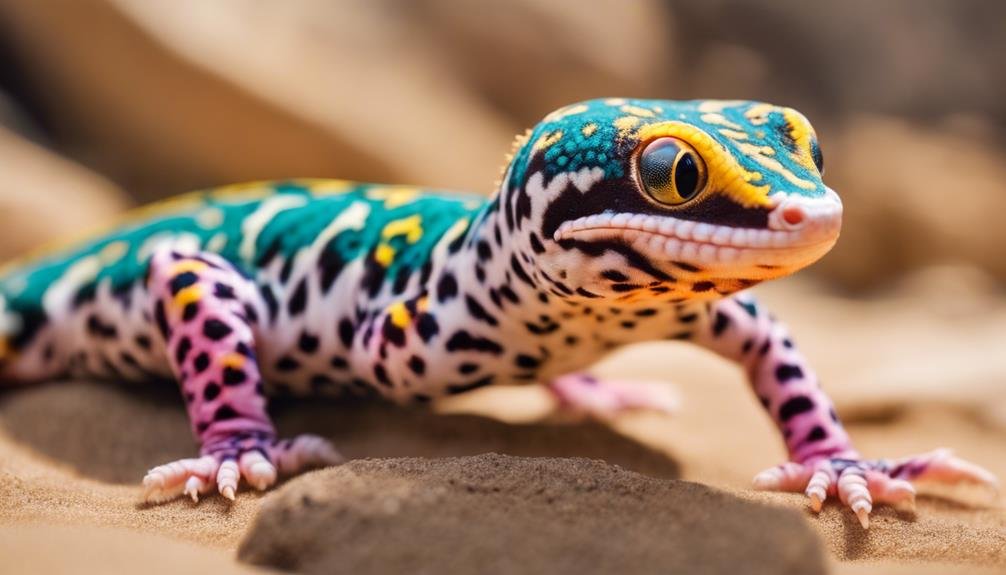When you think about leopard gecko morphs, you’re stepping into a world of incredible diversity in colors and patterns. Selective breeding and understanding genetic mutations are essential in producing these fascinating variations. You might wonder how breeders can predict specific traits and what genetic factors are at work. With over 100 unique morphs available, each with its unique charm, there’s much to uncover about their origins and characteristics. How do breeders guarantee healthy morphs while maintaining these stunning appearances? Let’s explore the complexities and beauty of leopard gecko morphs further.
Key Takeaways
- Leopard gecko morphs are diverse variations in color and pattern achieved through selective breeding and genetic mutations.
- Over 100 unique leopard gecko morphs exist, each with distinct characteristics.
- Popular morphs include High Yellow, Super Snow, Carrot Tail, Tremper Albino, and Enigma.
- Genetic factors like dominant, recessive, co-dominant, and polygenic traits determine morph appearances.
- Some morphs, like Noir Désir and Super Snow, may have health issues such as deformities and infertility.
Understanding Leopard Gecko Morphs
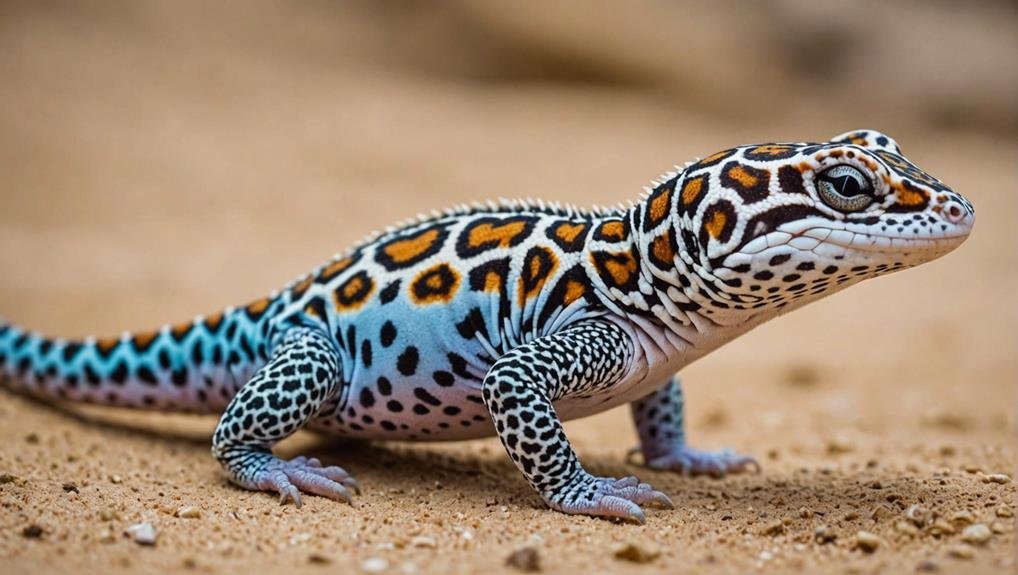

To truly appreciate the fascinating world of leopard gecko morphs, you must understand how selective breeding and mutations create their diverse color and pattern variations. Leopard gecko morphs refer to the different color morphs and patterns that arise within the species, achieved through careful breeding practices and spontaneous genetic mutations. By mastering the genetics and inheritance patterns, breeders can predict and produce specific morphs, leading to an impressive array of over 100 unique variations.
Breeding leopard geckos involves selecting individuals with desirable traits and pairing them to enhance or combine these characteristics. For instance, breeders might choose geckos with vibrant color morphs or distinctive patterns to create new and exciting morphs. Understanding the underlying genetics is vital, as it allows breeders to anticipate which traits will be passed down to the offspring. They can achieve specific outcomes by manipulating these genetic factors and consistently producing geckos with the desired characteristics.
The complexity of inheritance patterns means some morphs are more challenging to produce and may take several generations to stabilize. However, the result is a captivating variety of leopard gecko morphs, each with unique charm and appeal.
Popular Leopard Gecko Morphs
Leopard gecko enthusiasts have various popular morphs, each offering unique and enchanting traits. One fan favorite is the High Yellow morph, characterized by its bright yellow body and reduced black spotting.
If you’re drawn to striking patterns, the Super Snow morph, with its white and black speckled appearance, might catch your eye.
For those who love vibrant tails, the Carrot Tail morph stands out with its bright orange tail and lighter body colors. Tremper Albino geckos are another sought-after variety, known for their light coloration and varying degrees of pattern, often featuring pinkish hues.
The Enigma morph is particularly intriguing due to its random patterns and potential for neurological quirks, which add a unique charm.
Super Giants are perfect if you’re looking for an impressive size, as they can grow notably larger than standard leopard geckos. These giants make a bold statement in any collection.
With so many options, from the vividly colored Carrot Tail to the fascinating Enigma morph, there’s a morph for every enthusiast’s taste.
Immerse yourself in the world of these captivating creatures and discover which morph speaks to you.
Genetic Factors in Morphs
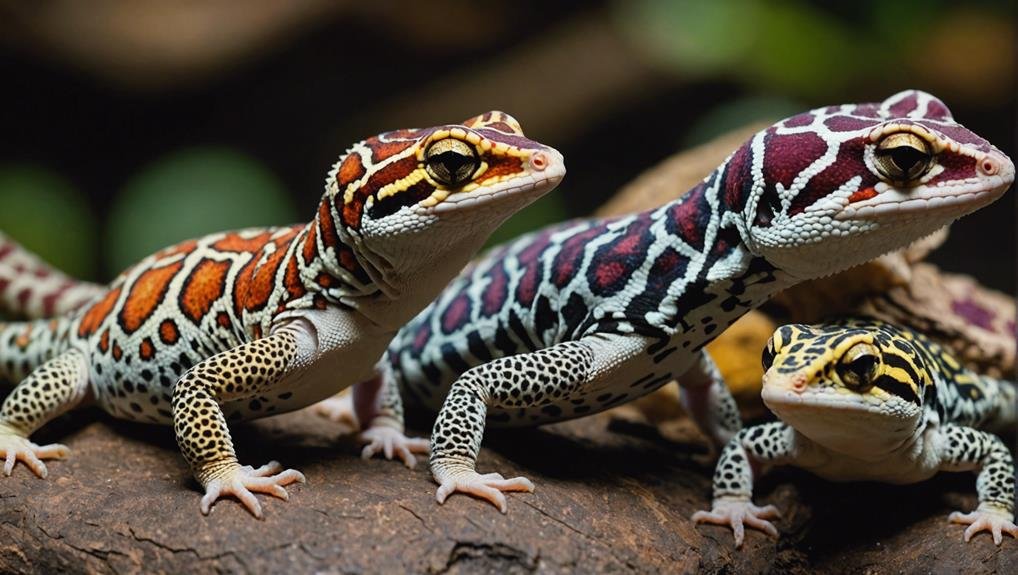

Understanding the genetic factors behind leopard gecko morphs can help you create stunning and unique combinations in your breeding projects. Leopard gecko morphs result from various genetic factors, including dominant, recessive, co-dominant, and polygenic traits. By knowing how these traits interact, you can predict and influence the appearance of your geckos.
For instance, Albino morphs lack melanin, resulting in lighter colors and red eyes. This trait is recessive, so both parents must carry the Albino gene for the offspring to display the morph.
On the other hand, Hypo morphs exhibit reduced black pigmentation, appearing in fewer spots or lighter coloration. Hypo traits are often co-dominant, meaning they can show partial expression even if only one parent carries the gene.
When planning your breeding projects, consider the inheritance patterns of each morph. Combining different morphs involves understanding these patterns and the statistical probabilities of offspring traits. You’ll need to account for the complexity of genetic combinations and sometimes multiple generations to achieve your desired results.
Careful planning and knowledge of genetic factors will enhance your ability to produce beautiful and unique leopard gecko morphs.
Common Morph Combinations
When you grasp the genetic factors behind leopard gecko morphs, you can explore popular combinations like Tangerine, Carrot Tail, Lavender, Halloween Mask, and various Albino types. These combinations are highly sought-after due to their unique and vibrant appearance, making them favorites among breeders and collectors.
Tangerine morphs stand out with bright orange hues ranging from a soft pastel to a deep, vivid shade. Carrot-tail geckos are another eye-catching variety, featuring vibrant orange tails that contrast beautifully with their lighter body colors. Lavender morphs offer a different aesthetic, presenting light violet or lavender bodies that add a subtle yet striking color variation.
The Halloween Mask morph is particularly striking, displaying a mix of white and yellow patterns accented with vivid black spots. This combination makes them look like they’re wearing a spooky mask, hence the name.
Albino variations, including Tremper Albino, bring another layer of diversity. These geckos have light bodies adorned with distinct spot and blotch patterns, making them visually appealing and unique.
Health Issues in Morphs
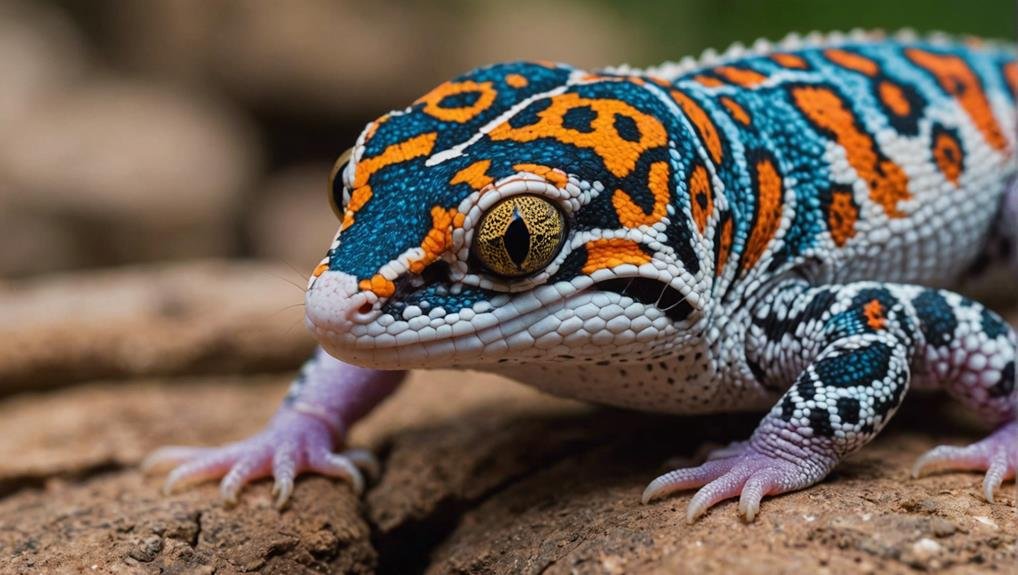

Many leopard gecko morphs come with health issues that potential owners and breeders should be aware of. For instance, Noir Désir morphs are frequently linked to eye deformities and possible infertility, making them a challenging choice for breeding.
Additionally, breeders have reported incubation-related deformities when Mack Snow morphs are combined with Rainwater morphs, highlighting the risks of certain morph combinations.
Super Snow morphs have been rumored to suffer from deformities, infertility, and slow growth, although solid proof is still lacking. However, monitoring these geckos closely for any signs of health issues is crucial.
Stealth geckos, a complex blend of Bell albino, Mack Snow, Enigma, and Eclipse morphs, exhibit extreme light sensitivity and require special care.
APTORS and RAPTORS, particularly those with Tremper het. Eclipse combinations also face light sensitivity issues. These geckos may need environments with controlled lighting to safeguard their well-being.
When considering breeding or purchasing leopard geckos, it’s important to understand these potential health issues. Pay close attention to the specific morph combinations you’re dealing with to mitigate risks and promote the health and longevity of your geckos.
Breeder Experiences
Breeders often share many experiences that shed light on the challenges and rewards of working with various leopard gecko morphs. When delving into morph combinations, you’ll find that some pairings present unique hurdles. For instance, combining Mack Snow and Rainwater morphs can sometimes lead to incubation issues, though these aren’t typically tied to morph-specific deformities.
One common topic among breeder experiences is the increased light sensitivity in geckos with Eclipse combinations. This can require specific adjustments in their care to guarantee their well-being. Additionally, slow growth in certain lineages, such as Super Snow geckos, points to potential genetic influences on development. This means you must be patient and attentive when raising these particular morphs.
Infertility concerns also arise, particularly with morphs like Noir Désir, though concrete evidence is still lacking. Monitoring breeding pairs closely and being prepared for possible reproductive challenges is critical. Understanding these genetic influences and potential issues can greatly enhance your breeding success and the overall health of your leopard geckos.
Community Feedback
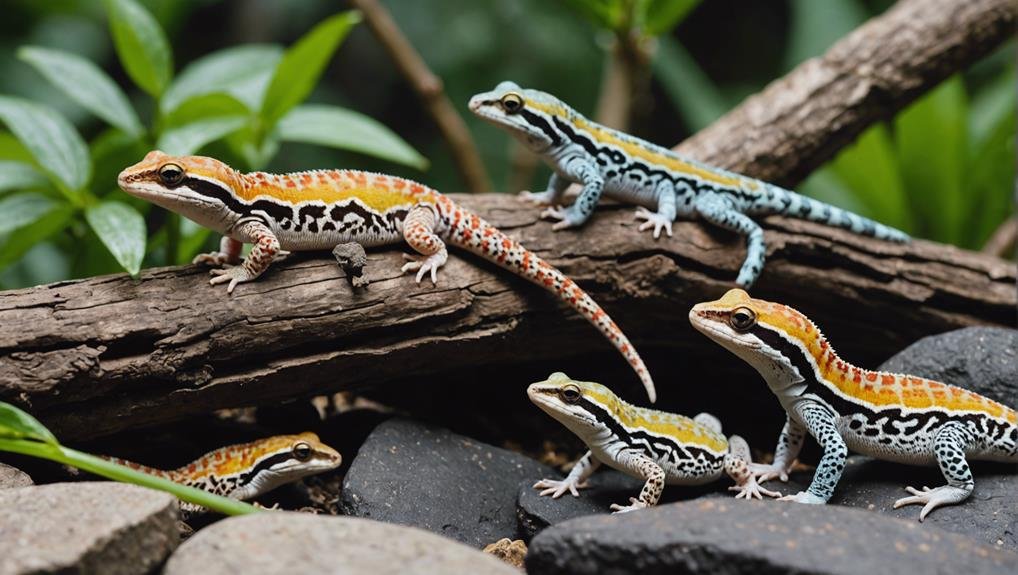

Community feedback on leopard gecko morphs is a treasure trove of insights and experiences, often highlighting enthusiasts’ triumphs and challenges.
Many breeders have shared mixed experiences with Super Snows. Some report varied growth rates, while others note potential deformities, which may be influenced by lineage. Additionally, temperature sexing in Super Snows and heterozygous Mack Snows has posed difficulties, adding an extra layer of complexity for breeders.
Eclipse morphs, particularly those combined into APTORS and RAPTORS, have frequently been observed with light sensitivity issues. This sensitivity can impact the geckos’ overall well-being and require careful management by their caretakers. However, this morph remains popular due to its striking appearance.
Concerns about potential infertility in Noir Désir geckos have surfaced within the community, although these reports aren’t widely confirmed. More data is essential to understand whether there’s a significant pattern or if these cases are isolated incidents.
Care Tips for Morphs
When caring for leopard gecko morphs, creating a habitat that accommodates their unique needs is essential, ensuring both cold and warm hides are available for ideal shedding. Proper habitat setup plays an important role in their overall health and comfort. You’ll want to provide a balanced environment that mimics their natural habitat, specifically concerning temperature and humidity.
A proper diet is equally significant. Feed your leopard gecko a mix of mealworms and crickets dusted with calcium powder to ensure they get the necessary nutrients. Regular supplementation with Reptical Reptile Calcium with Vitamin D3 supports their overall health and bone strength.
Hydration is another key factor. Always provide fresh filtered water to keep your leopard gecko well-hydrated, aiding regular shedding.
Here are some care tips to keep your leopard gecko morphs happy and healthy:
- Habitat Setup: Ensure both cold and warm hides for proper shedding.
- Diet: Feed mealworms and crickets dusted with calcium.
- Supplementation: Use Reptical Reptile Calcium with Vitamin D3.
- Hydration: Provide fresh filtered water at all times.
- Shedding: Maintain ideal humidity to assist in shedding.
Future of Leopard Gecko Morphs
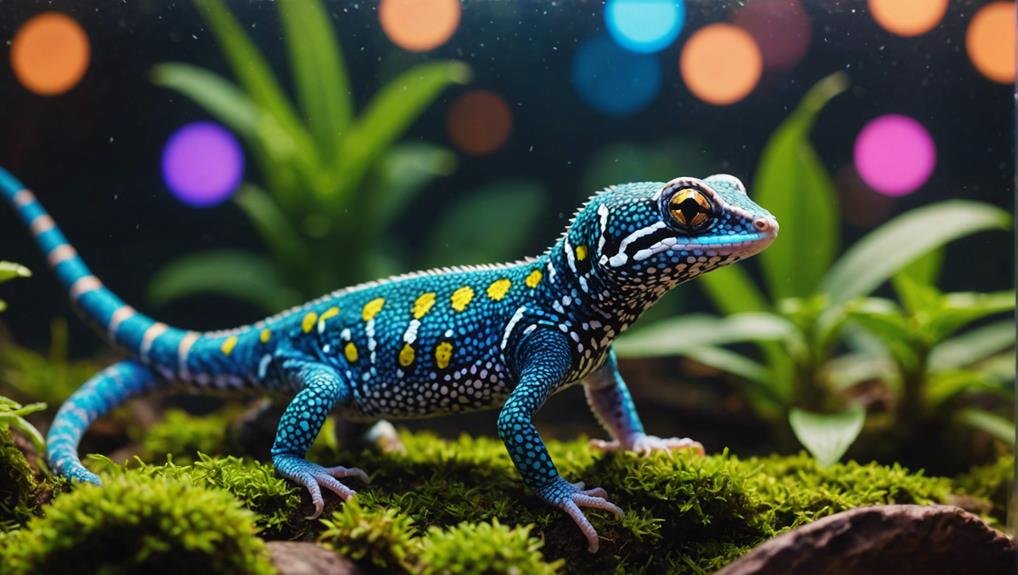

The future of leopard gecko morphs promises exciting developments as selective breeding produces new, stunning color combinations. Breeders are constantly pushing the boundaries to create unique and visually appealing morphs. With advanced future breeding techniques, you can expect an expansion in the variety of leopard gecko morphs available.
Genetic research plays a significant role in this evolution. By understanding the genetic makeup of these reptiles, breeders can more accurately predict and achieve desired traits. This research not only aids in creating new morphs but also guarantees the health and viability of the geckos.
The demand for rare morphs drives innovation and creativity within the breeding community. Enthusiasts are always on the lookout for exotic variations that stand out. As a result, breeders are motivated to experiment and perfect their techniques, developing even more extraordinary leopard gecko variations.
With over 100 existing color morphs, the possibilities for future morphs are almost limitless. With continuous advancements in genetic research and selective breeding, you can look forward to discovering some truly remarkable and unique color combinations in the coming years.
Conclusion
In exploring leopard gecko morphs, you’ve discovered the fascinating colors and patterns you can achieve through selective breeding. With a solid grasp of genetic factors and common morph combinations, you can immerse yourself in this rewarding hobby.
Always keep health considerations in mind and learn from fellow breeders’ experiences. With ongoing research and community support, the future of leopard gecko morphs promises even more stunning and unique variations for you to enjoy.

